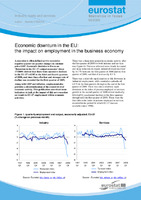| dc.description.abstract | In this section, the recent developments in output and employment within each of the Main Industrial Groupings (which group together similar industrial activities within an aggregate classification) are analysed. A few broad observations can be made for the Main Industrial Groupings (MIGs) of capital goods, durable consumer goods, intermediate goods, as well as for construction (see Figure 2): - across these activities, there was a relatively strong fall in the production indices after the first quarter of 2008; - there was an almost immediate change in the indices of hours worked and of persons employed, either accelerating existing downward trends or reversing rises; - in the four quarters since the first quarter of 2008, the rate of decline in the index of hours worked was stronger than the rate of decline in the index of persons employed, supporting the view that employers first reduce hours before making redundancies. Capital goods: the index of production for the EU-27 peaked in the firstquarter of 2008, after almost five years of sustained growth. In the year following that peak, the index of production for capital goods fell by 22.3 %, returning close to the level of the previous relative low reached in the second quarter of 2003. Of the two measures of employment presented in this publication, the decline in the number of hours worked in capital goods activities was the fastest to reflect the downturn in production, falling back in the second quarter of 2008 after two years of growth: the index of the number of persons employed started to decline one quarter later. By the end of the first quarter of 2009, the decline in the index of the number of hours worked in capital goods activities in the EU-27 had reached 6.2 %, twice the rate of the decline in the index of the number of persons employed. Intermediate goods: among all of the MIGs, the sharpest decline in output in the year to the end of the first quarter of 2009 was in intermediate goods; from the relative peak in the first quarter of 2008, output declined by 23.5 %, to its lowest level since the first quarter of 1997. After years of a relatively steady level of employment in these activities within the EU-27, the knock-on effect of this change in production was a decline of 9.1 % in the index of hours worked over the year between the first quarters of 2008 and 2009, with the index of persons employed also falling by 5.8 % in this same period. Durable consumer goods: the EU-27’s production index of durable consumer goods fell by almost one fifth (18.8 %) up to the end of the first quarter of 2009 from the relative peak one year earlier. The level of the EU-27’s production index at the end of the first quarter of 2009 was the lowest since the fourth quarter of 1993. This sharp and deep turn-about in production is also reflected in employment data. After years of relative stability in the indices of persons employed and hours worked within the grouping of durable consumer goods activities, there were also steep cutbacks in the year to the end of the first quarter of 2009. The index of hours worked fell by 9.1 % from the level recorded at the end of the first quarter of 2008, with the index of persons employed declining by 7.9 %. Non-durable consumer goods: the EU-27 indices for persons employed and hours worked in the grouping of non-durable goods activities fell at almost identical rates between the first quarters of 2008 and 2009 (-5.6 % and -5.5 % respectively). These rates were slightly steeper than for the index of production in the same period (-4.2 %). Energy: in contrast to the other MIGs, the volume of output of energy activities has been on a downward trend for a number of years. For much of this period, there was also a steady fall in the indices of persons employed and of hours worked, which broadly continued in the year after the first quarter of 2008.Construction: as a highly labour intensive sector, the sharp downturn in construction activities after the first quarter of 2008 was closely mirrored by the labour input indices. Against the background of a 10.3 % fall in the production index for construction activities in the year to the end of the first quarter of 2009, the index of hours worked in construction in the EU-27 declined by 7.2 % and the index of person employed reduced by 6.9 %. |

